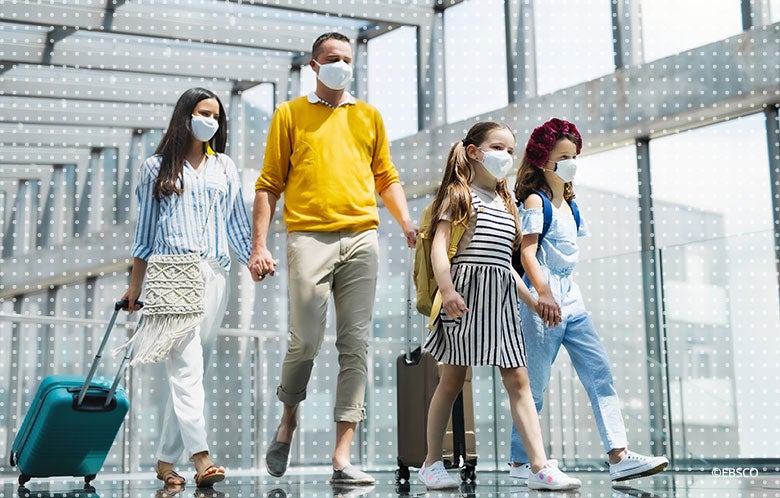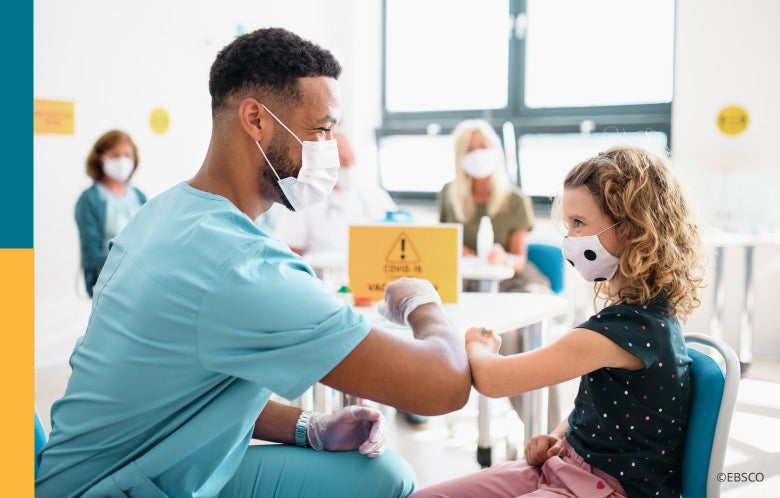The COVID-19 pandemic has been difficult for everyone in various ways. Healthcare workers need current, evidence-based information to diagnose and manage patients with COVID-19; but the public also needs to be informed in order to live, work, and play as safely as possible.
We likely learned more about the SARS-CoV-2 virus during the past two years than we have about any other pathogen or medical disorder in any other two-year span in history. According to the National Library of Medicine (NLM) resource LitCOVID, more than 225,000 articles related to COVID-19 have been published (that’s more than 300 per day) since the start of the pandemic. In addition to these, there are pre-print (not yet peer-reviewed) studies, pharmaceutical press releases, and regulatory documents about COVID-19, all of which contribute to recommendations for clinical practice and public health.
Sifting through the mountains of information and translating it into clear clinical and public messaging is a near impossible task, especially in a shifting landscape. With surges of new viral variants, a discovery that prompted one course of action earlier in the pandemic may not be relevant later. This does not mean that the conclusions drawn at a particular point in time are not valid, but that changing data and situations necessarily warrant new and/or updated guidance.
Take, for example, recommendations for masking, which apply to both healthcare and public settings. They have evolved (even flip-flopped) over the course of the pandemic based on new information and research. Here are five key turning points in mask recommendations throughout the past two years of this pandemic in the United States.
Beginning of the pandemic: No masks
When COVID-19 was mostly restricted to Wuhan, China, in late 2019 and early 2020, it did not make sense to recommend masks for the general public or in healthcare settings where masks weren’t already recommended. Put simply, there was not enough virus in most places around the world at that time for universal masking to have made a difference.
There were also concerns that there could be a shortage of N95 or equivalent masks for healthcare workers if everyone else went out and bought them. So, masks were not only not recommended, but the public messaging was that they were recommended against (as the public was told not to buy masks). In hindsight, this messaging led to confusion about the usefulness of masks in later stages of the pandemic.
The first global wave: Mask up
Once it was clear that SARS-CoV-2 was spreading globally in early-to-mid 2020, it became important to recommend wide-spread masking. Because many respiratory viruses and other coronaviruses are transmitted primarily via respiratory droplets and contact with contaminated surfaces (fomites), it was reasonably assumed that SARS-CoV-2 was transmitted the same way. Though an educated assumption, it contributed to contention about the utility of masking.
For instance, the focus on fomites led to infection control recommendations for the public that mostly focused on physical distancing, handwashing, and disinfecting surfaces. While these are good hygienic practices, they are not necessarily the most important protections for pathogens with airborne spread, notably because aerosol particles don’t drop to surfaces as quickly as droplets, and they can stay in the air beyond six feet.
When super spreader events and epidemiologic contact tracing studies revealed an atypical pattern for droplet and fomite transmission, public health messaging was slow to change. Eventually, understanding that aerosol transmission was a mode of spread for SARS-CoV-2 necessitated changes to recommendations that included masking indoors - as a means of source control - in addition to other protections such as increasing indoor ventilation and promoting outdoor activities as alternatives to indoor gatherings. Ultimately masking with cloth, surgical, or N95 masks was recommended in all public settings (indoor and outdoor).
This does not mean that the conclusions drawn at a particular point in time are not valid, but that changing data and situations necessarily warrant new and/or updated guidance.
This does not mean that the conclusions drawn at a particular point in time are not valid, but that changing data and situations necessarily warrant new and/or updated guidance.
Vaccines work: Masks off (for some people, in some settings)
Spring to summer of 2021 was a time of great hope as vaccination rates grew and COVID-19 case numbers plummeted. Two recommendations related to masking shifted during this time. First, it was now clear that masking was not necessary in outdoor settings, unless these were crowded. Second, masking was no longer needed indoors a) in areas of low-moderate community transmission and b) if people were fully vaccinated. The logic was that the drastically lower likelihood of infection in vaccinated individuals meant that masking for source control was unlikely to be beneficial to the community at large.
With the focus on community transmission profiles during this phase of the pandemic, the Centers for Disease Control and Prevention (CDC) started tracking community transmission in every county across the United States.
Delta and Omicron surges: Masks on (and upgraded)
The Delta surge may not have started with the Provincetown Fourth-of-July outbreak, but it certainly marked another important shift in mask recommendations. The Delta variant was about 50 percent more contagious and caused more breakthrough infections in vaccinated individuals than previous variants, making masks crucial to public safety once again.
When Omicron swept through the world at record pace, it was estimated to be about 66 percent more transmissible than Delta. By the start of 2022, Omicron accounted for more than 90 percent of infections globally. In fact, Omicron has contributed to the greatest surge of COVID-19 so far, peaking at 21 million cases globally the week of January 17-23, 2022.
With rise of contagion due to Delta and Omicron, the public health messaging was not only to put masks back on to slow the spread of these variants, but to upgrade to well-fitting masks, with evidence showing that N95 masks or equivalent were best.
Today: Masks off (in certain areas)
With case numbers on the decline, mask recommendations are once again variable by local transmission. However, this time around the CDC is including hospitalization rates and inpatient bed occupancy rates in addition to COVID-19 cases when assessing community risk. Masks may be omitted in public in areas of low-medium COVID-19 community levels. Notably because vaccination is not as protective against Omicron infection as previous variants, this recommendation applies to everyone regardless of vaccination status.
In areas of low-medium community levels, well-fitting masks are still recommended for protection for individuals with certain medical conditions or taking medications that weaken their immune system. And masks remain required on planes, trains, buses, and other forms of public transportation including in hubs such as airports and stations.
While this feels like the dawn of another optimistic phase, the tide could turn again. Despite the frustration, we’ve learned a lot throughout the past two years of this pandemic and data will continue to help guide us forward, even if it sometimes feels like we’re taking a step back.



